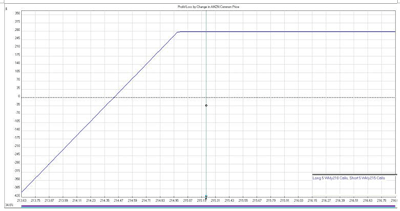Weekly options are valuable tools for capitalizing on short-term market moves, and this recent trade example in Amazon.com (AMZN) shows key points for identifying set-ups and executing more effectively.
One of the things an option trader must keep in mind is to try to match the option strategy to the situation at hand. All of us at times have had the disconcerting situation of having predicted price correctly, but having structured the trade such that the response of the position to a quick price movement is minimal.
The recent availability of weekly options has given much more flexibility to traders who wish to exploit rapid price movement. At times, the option Gods smile upon us and even provide an opportunity to capture significant profit if price moves a bit or even stays the same.
Such an opportunity presented itself on Friday, July 22 in Amazon.com (AMZN). As most traders know, AMZN is extremely liquid and has a very tight and liquid options chain. For those just learning the lingo of options, tight markets refer to a very small bid/ask spread. What may not be as well known to traders is the fact that this equity has an extremely active market in the weekly options series. These attributes form a very attractive scenario for trading quick moves using the weeklies when an appropriate price pattern can be identified.
Let us consider a couple of important background pieces of knowledge before looking at the trade. Weekly options in AMZN can be traded beginning the Thursday of the week prior to their expiration and they trade until the closing bell of the Friday of their expiration week.
During this nine-day lifespan, the extrinsic (time) premium goes from its maximum value to zero. Time premium on these weekly options will always have vanished when the bell rings Friday afternoon. Traders have very few things which reliably happen. The extraction of time premium is inevitable and I used it to my advantage in structuring this trade.
Let us now take a look at the intraday price pattern of AMZN on Friday, July 22.
Article Continues on Page 2
|pagebreak|The five-minute candle chart is displayed below:
The horizontal line on the chart represents the opening range breakout in price that began around 12:30 ET from a multi-bar price consolidation just above $212. When I noticed this breakout, I began to look at the options board to see what might make sense. Now remember, this breakout occurred in a very short-term chart, the five-minute time frame. It was imperative to match the pace of the options trade structure with the time frame from which the pattern developed.
I knew that the liquid weekly options had only four remaining hours of life, and that as we discussed above, the time premium must go to zero at the bell. Additionally, I knew that another reliable factor was in play—the fact that the at-the-money option strike always contains the most embedded time premium. As it turned out, the at-the-money strike was only a short distance above the current price.
A quick check of the quoted prices indicated that the weekly 210/215 vertical call spread could be bought for a $4.40 debit per spread. This spread would be worth $5 if AMZN closed at or above $215 in four hours. The graphical display of this trade is presented below:
As the earlier price chart showed, AMZN continued to climb into the afternoon before a small selloff into the bell. I was able to exit the trade for a few pennies less than its maximum value two hours after entering the trade for a total return on capital of 11.8%.
An important learning point in this trade is the mechanics of the exit. As we have discussed, the position had a maximum value of $5.00 if AMZN closed at $215 or greater. Despite the fact that AMZN was trading as high as $218 with only a couple of hours to go, the spread was bid at approximately $4.70.
This sequence of events teaches two important points:
- One is the critical importance of using limit orders to exit trades
- Option traders must understand how to recognize the value of an options position
The savvy trader comes to the table with this knowledge as well as the knowledge that he may have to “wait out” the market makers in order to achieve a fair price. Having said this, options traders should never be afraid to give a few pennies to exit a trade which has achieved the profit objective. The psychological cost of seeing a successful trade suddenly go to a loss is significant.
By JW Jones of OptionsTradingSignals.com












